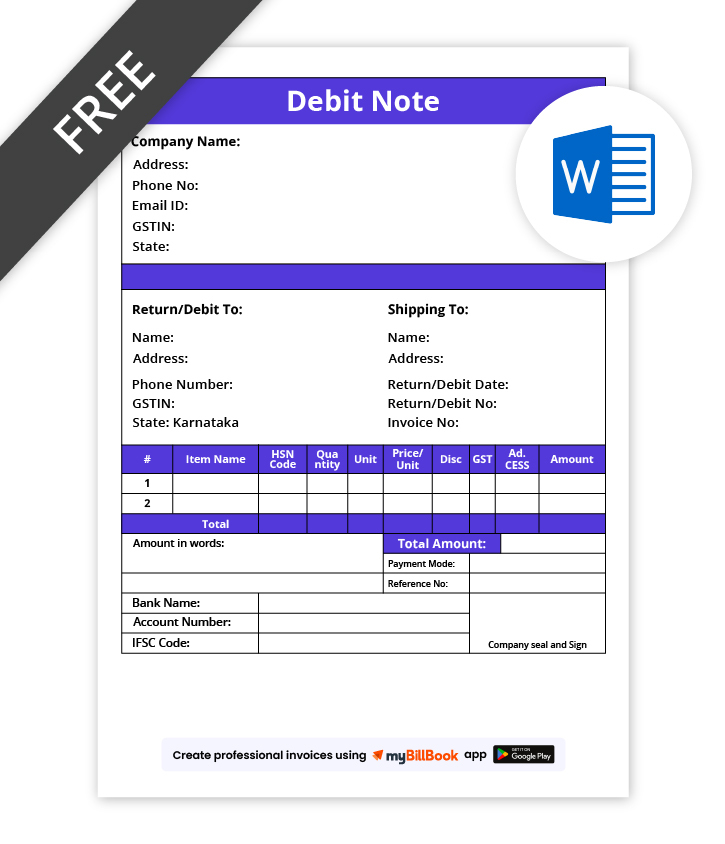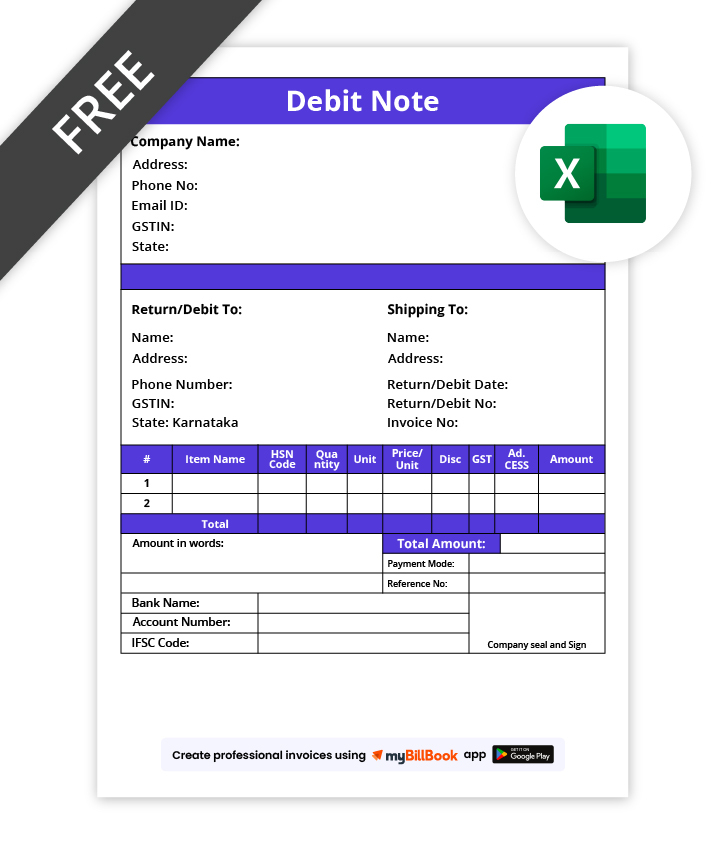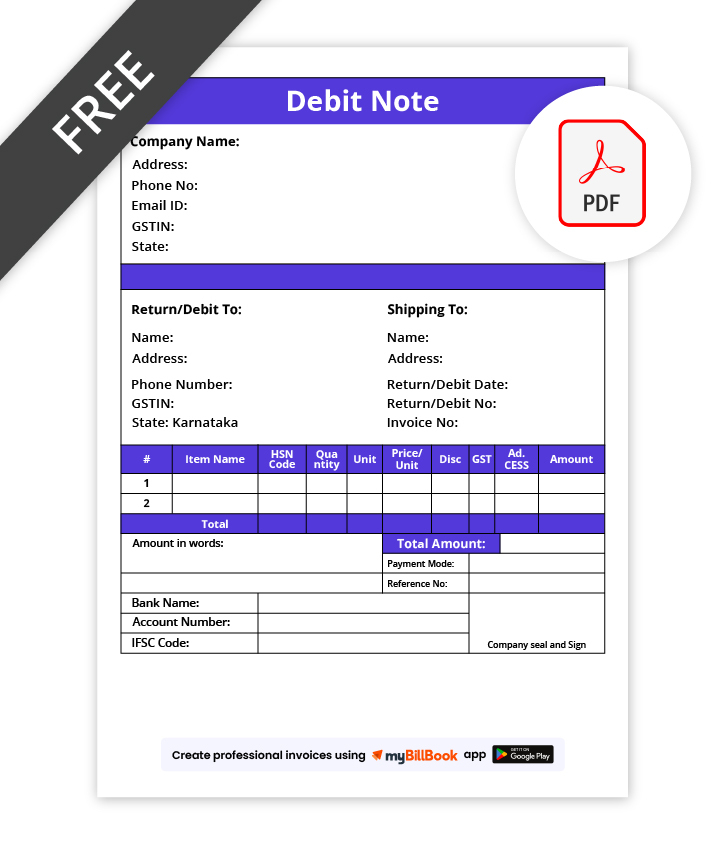Debit Note Format
Stay compliant with GST debit note formats tailored for Indian businesses. Whether you’re a retailer, distributor, or manufacturer, ensure accurate adjustments for undercharged invoices and purchase returns.
myBillBook billing solution offers editable debit note templates in Word, Excel, and PDF — making it quick and simple to generate GST-compliant debit notes linked to original invoices.
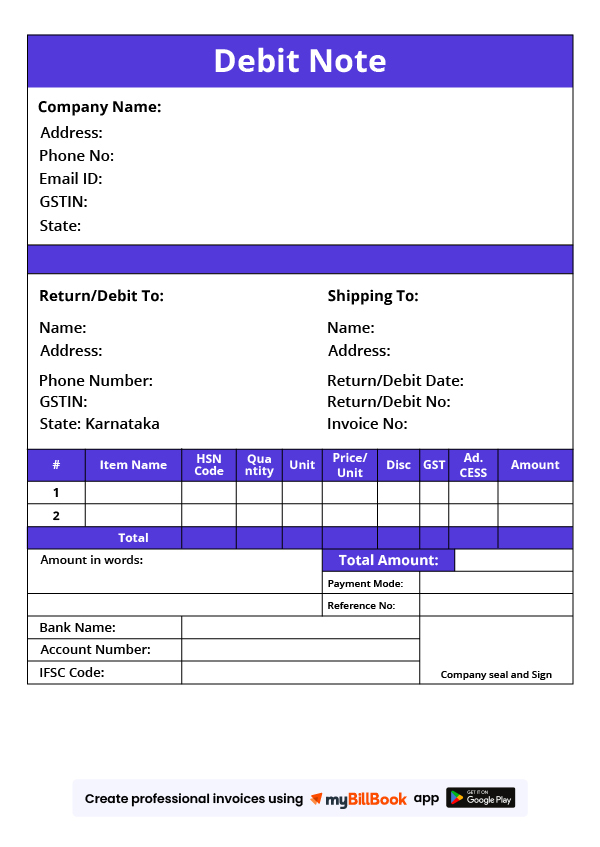
Free GST Debit Note Format Templates
Get professional debit note formats for GST under Section 34, compatible with MS Word, Excel & printable PDF. Ideal for SMEs needing adjustment notes for suppliers and customers.
Explore Premium Debit Note Format Templates
Features of myBillBook Debit Note Format

Invoice Linking
Link debit notes to original invoices instantly. Auto-fetch invoice number, date, and party details, ensuring accurate adjustments and proper compliance.

Auto Tax
Automatically compute CGST, SGST, IGST, and cess on value differences. Remove manual errors and guarantee every debit note is fully GST-compliant and accurate.

HSN/SAC Codes
Fetch HSN/SAC codes directly from your item catalog. Ensure proper classification of goods/services and accurate reporting in debit notes for GST compliance.

Stock Sync
Issuing debit notes for purchase returns updates inventory in real time. Maintain precise stock levels without manual effort, preventing shortages or overstock issues.

Custom Templates
Personalise debit note templates with your logo, GSTIN, address, numbering, and predefined reasons. Present professional documents tailored to your business needs.

GSTR-1 Ready
Generate GSTR-1 reports including debit notes automatically. Ensure fast, error-free GST return filing with accurate data synced from your transactions directly into reports.
What is a Debit Note Format
A Debit Note Format in GST is a structured template used by a supplier to issue a debit note under Section 34 of the CGST Act when the taxable value or tax charged in the original tax invoice needs to be increased.
It contains essential GST fields such as supplier details, buyer details, original invoice reference, HSN/SAC codes, revised taxable values, and applicable taxes like CGST, SGST, and IGST. Using a proper debit note format ensures legal compliance, transparent value adjustments, accurate bookkeeping, seamless reporting in GSTR-1, and helps maintain clear records for audits, dispute resolution, and business credibility.
Use myBillBook free invoice tool to generate correct GST invoices before adjustments.
Debit Note in GST
As per the GST rules, when a seller issues a tax invoice, a debit note has to be issued if any of the below situations arises.
- If the seller creates the invoice with a value less than the actual value of goods or services provided.
- If the seller includes a lower tax value than the actual tax applicable for the goods or services sold.
- If the seller sends more quantity of goods or services than those priced in the invoice.
To regularise these kinds of situations, the seller can issue a debit note to the customer. Thus provided debit note includes a supplementary invoice.
Sample of Debit Note Format
Below is a sample debit note format for GST (Section 34) that demonstrates the standard layout and field order. It shows how to reference the original tax invoice, list items with HSN/SAC, and capture taxable value differences. Note the CGST/SGST/IGST breakup, reason for issue, and serial numbering to keep records audit-ready. Use this example to structure your own debit notes or map fields in myBillBook templates.
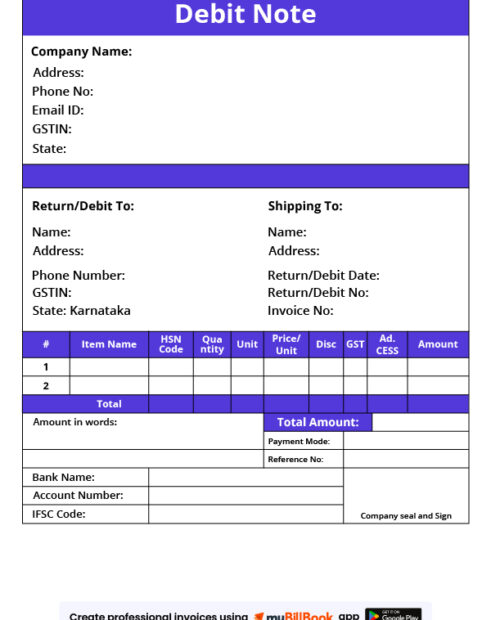
Debit Note Format – Details to Include
As per the GST regulation, there is no prescribed template for debit notes. However, it mandates the mention of the following particulars in a debit note.
| Seller’s Information | Details of the seller – name, address, and GSTIN (goods and services tax identification number) |
| Document Type | Name of the document – debit note or credit note |
| Serial Number | A unique consecutive serial number (not exceeding 16 characters and contains numbers, alphabets, alphanumeric, or special characters) |
| Date | Date of issue of document |
| Buyer’s Information | Details of the buyer – name, address, and GSTIN (in case of a registered business) |
| Other details to mention | Serial number and date of the actual invoice or bill |
| Value of goods as mentioned in the previous invoice, tax rate, and amount of tax credit to the buyer | |
| Signature of the supplier or authorised representative |
Debit Note Format Template in Different Formats – Word, Excel, PDF
Debit note templates can be created in many different templates and formats depending on your business needs and preferences. You can find free debit note templates online in various file types, including Excel, Word, PDF, and Google Docs. Some templates are more basic, while others are more detailed and include additional features such as automatic calculations.
Debit Note Format in Word
If you prefer to use Word to create your debit note, you can use a template or create your document from scratch.
To create a debit note format in Word, input the necessary information, such as the seller’s name and contact information, the buyer’s name and contact information, the invoice number, and the corrected amount. You can also include additional details, such as the reason for the correction and any other relevant information.
Debit Note Format in Excel
A better alternative to debit note format in Word is using MS Excel, which is an easy tool to deal with data and numbers.
To create a debit note format in Excel, open a blank Excel sheet, define the fields, enter the required headings for each field, specify the formulas for the addition of price, input tax, to auto-populate date, etc. Once all the required fields are defined, you can save the debit notes format.
Whenever, you wish to create a debit notes format in Excel, make a copy of the sheet, enter the customer and invoice details, and use it.
Debit Note Format in PDF
PDF is a popular tool for creating debit note format in PDF because it is easy to read and share and preserves the document’s formatting. To create a debit note in PDF, you can use a template or create your document using a PDF editor.
You’ll need to input the necessary information, such as the seller’s name and contact information, the buyer’s name and contact information, the invoice number, and the corrected amount. You can also include additional details, such as the reason for the correction and any other relevant information.
Creating Debit Note Format Using myBillBook
Using the myBillBook app to create and manage debit notes has several benefits, including
Convenience: The app allows you to create and send debit notes from anywhere, at any time, using your mobile device.
Accuracy: The app automatically calculates the total debit amount and helps you to ensure that all required information is included.
Efficiency: The app’s user-friendly interface and templates make it easy to quickly create and send debit notes.
Security: The app stores your debit notes securely and allows you to track and manage them easily.
A debit note helps request credits or adjustments from suppliers or other business partners. By using a debit note template and following a consistent format, you can ensure that your credit requests are clear and professional. myBillBook app can help you create and manage debit notes, helping you to streamline your financial processes and resolve any issues quickly and efficiently.
The jewellery billing software from myBillBook can help you create and manage debit notes, streamlining your financial processes and allowing you to resolve any issues quickly and efficiently.
Benefits of using myBillBook to Generate Debit Notes
myBillBook is a comprehensive billing and accounting software that helps businesses create GST-compliant debit notes more efficiently. Listed below are the features offered by myBillBook invoicing software.
- myBillBook helps you calculate CGST, SGST, IGST, cess, and revised values automatically.
- Users can link debit notes directly to original invoices for accurate adjustments.
- Purchase returns automatically update inventory levels in real-time.
- You can customise debit note templates with your logo, GSTIN, and numbering.
- myBillBook is cloud-based, accessible via web, Windows, and Android.
- Supports multiple languages like English, Hindi, Gujarati, and Tamil.
- Create and share debit notes via WhatsApp anytime.
- Integrated with GSTR-1 reporting for faster GST filing.
- Offers 24/7 customer support for queries and assistance.
Frequently Asked Questions
What is the debit note format?
A debit note format is a standardised layout or template for creating a debit note, a document requesting a credit or adjusting an account.
What is a debit notes template in PDF?
A debit note PDF is a debit note in the Portable Document Format (PDF) that can be opened and viewed on any device with a PDF reader.
How do I display a debit note format?
You can display a debit note by printing it or viewing it electronically on a computer or mobile device.
What is a debit note journal entry?
A debit note journal entry is an accounting entry that records the issuance of a debit note. This entry involves a debit to an account like "Accounts Receivable" and a credit to an account such as "Sales Returns and Allowances."
Who prepares the debit note format?
A seller or vendor prepares a debit note when requesting a credit or adjustment to the buyer's account. However, the buyer may also prepare a debit note if they request a credit or adjustment from the seller.
Is a debit note mandatory under GST?
Yes. Under Section 34 of the CGST Act, a debit note must be issued by a supplier when the taxable value or tax charged on the original invoice increases.
What is the difference between a debit note and a credit note?
A debit note increases the buyer’s payable amount (undercharged earlier), while a credit note reduces it (excess charged or goods returned).
What details should be included in a GST debit note format?
A GST debit note must include supplier details, buyer details, GSTINs, original invoice reference, HSN/SAC codes, revised value, applicable tax, reason, and authorized signature.
Can I generate debit notes using billing software?
Yes. Tools like myBillBook allow you to create GST-compliant debit notes automatically, link them to invoices, update stock, and integrate with GSTR-1 filing.
How long should debit notes be kept for GST compliance?
As per GST rules, debit notes must be preserved for 72 months (6 years) from the date of filing the annual return for the relevant financial year.
Know More About Bill Formats

